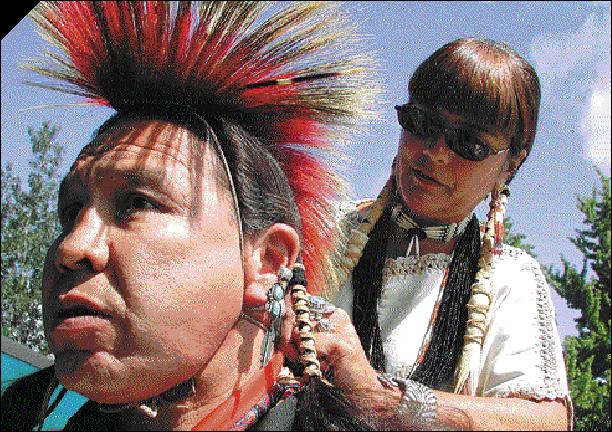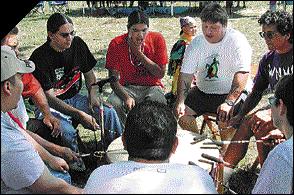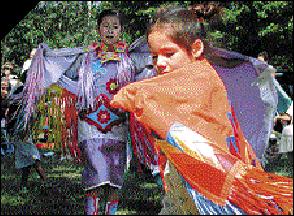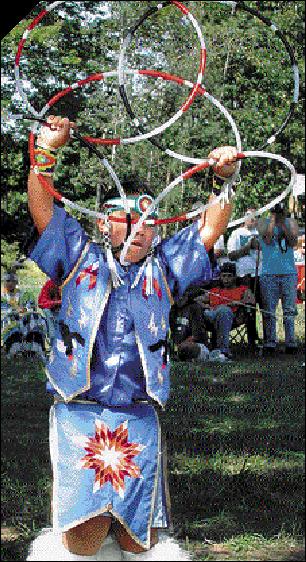August 28, 2002

Herald photos by Garret Leiva
Hank Bailey, a men’s traditional dancer, receives help from his fiancee, Amy before taking part in a powwow held Saturday on the Northwestern Michigan fairgrounds. The traditional powwow was sponsored and organized by two area families.
Powwow honors Native American history and culture
By Carol South
Herald contributing writer
A portion of the Northwestern Michigan fairgrounds was transformed over the weekend into sacred ground as three Native American tribes held a powwow. Members of the Ottawa, Ojibwa and Potawatomi tribes, which comprise the Three Fires Council, participated
in the event.
The powwow drew 1,200 attendees from the general public, plus countless members of Native American tribes. The event also featured food, crafts and a chance to learn more about the history of native people.
The powwow was a swirling rainbow of outfits and fringes, a symphony of beads and bells as dances included the men’s traditional, women’s traditional, the crow, women’s shawl and men’s grass. The Medicine Lodge Singers of Peshawbestown and Spirit Arbor provided
the drumming and singing throughout the weekend.
The powwow also featured a strong theme of patriotism. After the opening Grand Entrance, which represented the coming of human beings on Mother Earth, the contributions of Native American veterans were detailed, including service in the country’s armed forces
dating back to the Revolutionary War.
Inclusiveness was another key to the powwow, as members of the audience were invited to participate in numerous intertribal dances, celebrating a common bond of humanity.
“We wanted the chance for the public to see an accessible powwow so they could see first hand Native American tradition,” said Jonathan Ogemaw Gegedo of Traverse City, one of the event’s organizers. “We do a powwow during the Cherry Festival, but there are
so many other things going on, here people can come and spend the whole day.”
The movement among Native Americans to honor their heritage has been increasing for the past 10-15 years, said Ogemaw Gegedo. Powwows, which used to number fewer than ten a summer, are now held on every weekend. They provide an excellent way to pass on cultural
heritage and pride to younger generations.
“One of our themes at this powwow is to honor our youth,” he said. “Our kids need to be raised up this way to understand why we dance, what we dance for.”
Andrew Anderson of Suttons Bay has been dancing since he was three years old. Now 16, he took a few years off and just this summer started participating in powwows and grass dancing, a traditional dance for young men.
“This is a piece of my culture,” said Anderson, who travels with the Medicine Lodge Singers to different powwows.
Lisa Shawandase reconnected with her culture more than 20 years ago when she moved to Peshawbestown from the Grand Rapids area. The lead female dancer at the powwow and a jingle dress dancer, Shawandase began dancing 10 years ago because of a dream.
A member of the Grand Traverse Band of Ottawa and Chippewa Indians, one night Shawandase had a clear vision of a dress covered in cone-shaped bells. She visited with tribal elders, bringing them tobacco, for guidance; the elders sent her to female elders.
These women told her the dress she saw was a medicine dress. She was being called to make a jingle dress and learn the traditional dances associated with it.
So Shawandase began sewing, painstakingly attaching 365 cone-shaped bells to her dress, each one signifying a day of the year.
Immersing herself in her native culture has been very satisfying for the Peshawbestown resident.
“When I was growing up I didn’t have much exposure to my culture,” Shawandase said. “My mother would take us to powwows but that was about it.”
“Since I moved up here in 1979, I’ve been learning about our traditions and learning the language,” she noted. “My daughter is 12 and she’s shawl dancing.”
Hoop dancer Derek D’Artagnon of Mount Pleasant is only nine years old but is already a veteran of world championship Native American dance competitions. D’Artagnon has been hoop dancing since he was three and was fortunate enough to have the then-world champion
hoop dancer teach him the steps and make his hoops.
“I like the spiritual feeling when I dance it,” said D’Artagnon, who practices mainly by visualization. “Dance is symbolic of different forms of animals, like a caterpillar turning into a butterfly.”

Members of Medicine Lodge Singers provide music for an inner tribal dance in which people from all tribes were encouraged to dance together.

Above: Bright colors swirl as these young girls participate in a shawl dance. The weekend powwow featured a number of men’s and women’s dances including traditional, grass and a jingle dress dance.

Derek O’Artagnan, 9, of Mount Pleasant performs a hoop dance taught to him by world champion hoop dancer Derek Davis. The dance features several intricate transformations into such shapes as an eagle, snake, flower and butterfly.



